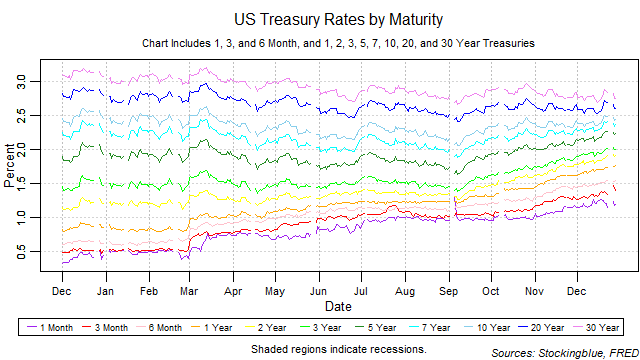
Short-term rates and medium-term rates continued to rise in December while long-term rates dropped from the previous month. The yield curve continued to narrow as it had in the previous month. Short-term rates have increased their rise in rates but the one-month bill had no sessions with higher rates than the three-month bill. That is, the one-month bill maintained the lowest rate throughout the month. However, the yield curve narrowed from both the short and long-term. A narrowing from the short-term is a warning sign for an inversion that indicates recession.
Findings
- All rates from the one-month to the ten-year rose in December while the 20 and 30-year rates both dropped.
- The one-year rate saw the largest absolute growth at 0.14 points.
- The 30-year rate saw the largest drop at 0.08 points.
- On a relative basis, the three-month rate grew the most with an 9.45 percent rise.
- The 30-year rate dropped the most on relative terms with a 2.83 percent drop.
- The one-month bill maintained the lowest rate throughout the month for the third time in five months.
- The yield curve narrowed 0.13 points.
Caveats
- As always, past performance is not indicative of future results.
- The rates have been at historic lows for quite some time which has not occurred previously.
Details

The breadth of the yield curve narrowed over the month from a range of 1.62 to a range of 1.56. The widest range was 1.68 on December 22 and the narrowest 1.44 on December 15.

The thirty-year bond held the highest rate throughout the month, although the rate has been fluctuating wildly throughout the course of the month and trending downwards.

The one-month note held the lowest rate for every session. However, it has been rising steadily throughout the course of the month.
Sources
"Treasury Constant Maturity," Federal Reserve Bank of St. Louis, accessed December 30, 2017, https://fred.stlouisfed.org/categories/115.